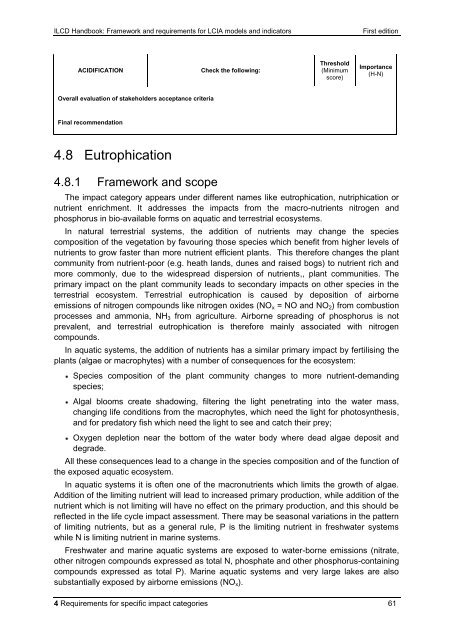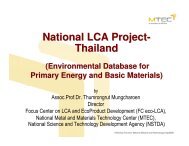ILCD Handbook: Framework and requirements for LCIA models and ...
ILCD Handbook: Framework and requirements for LCIA models and ...
ILCD Handbook: Framework and requirements for LCIA models and ...
Create successful ePaper yourself
Turn your PDF publications into a flip-book with our unique Google optimized e-Paper software.
<strong>ILCD</strong> <strong>H<strong>and</strong>book</strong>: <strong>Framework</strong> <strong>and</strong> <strong>requirements</strong> <strong>for</strong> <strong>LCIA</strong> <strong>models</strong> <strong>and</strong> indicators First edition<br />
ACIDIFICATION Check the following:<br />
Overall evaluation of stakeholders acceptance criteria<br />
Final recommendation<br />
4.8 Eutrophication<br />
4.8.1 <strong>Framework</strong> <strong>and</strong> scope<br />
Threshold<br />
(Minimum<br />
score)<br />
Importance<br />
(H-N)<br />
The impact category appears under different names like eutrophication, nutriphication or<br />
nutrient enrichment. It addresses the impacts from the macro-nutrients nitrogen <strong>and</strong><br />
phosphorus in bio-available <strong>for</strong>ms on aquatic <strong>and</strong> terrestrial ecosystems.<br />
In natural terrestrial systems, the addition of nutrients may change the species<br />
composition of the vegetation by favouring those species which benefit from higher levels of<br />
nutrients to grow faster than more nutrient efficient plants. This there<strong>for</strong>e changes the plant<br />
community from nutrient-poor (e.g. heath l<strong>and</strong>s, dunes <strong>and</strong> raised bogs) to nutrient rich <strong>and</strong><br />
more commonly, due to the widespread dispersion of nutrients,, plant communities. The<br />
primary impact on the plant community leads to secondary impacts on other species in the<br />
terrestrial ecosystem. Terrestrial eutrophication is caused by deposition of airborne<br />
emissions of nitrogen compounds like nitrogen oxides (NOx = NO <strong>and</strong> NO2) from combustion<br />
processes <strong>and</strong> ammonia, NH3 from agriculture. Airborne spreading of phosphorus is not<br />
prevalent, <strong>and</strong> terrestrial eutrophication is there<strong>for</strong>e mainly associated with nitrogen<br />
compounds.<br />
In aquatic systems, the addition of nutrients has a similar primary impact by fertilising the<br />
plants (algae or macrophytes) with a number of consequences <strong>for</strong> the ecosystem:<br />
Species composition of the plant community changes to more nutrient-dem<strong>and</strong>ing<br />
species;<br />
Algal blooms create shadowing, filtering the light penetrating into the water mass,<br />
changing life conditions from the macrophytes, which need the light <strong>for</strong> photosynthesis,<br />
<strong>and</strong> <strong>for</strong> predatory fish which need the light to see <strong>and</strong> catch their prey;<br />
Oxygen depletion near the bottom of the water body where dead algae deposit <strong>and</strong><br />
degrade.<br />
All these consequences lead to a change in the species composition <strong>and</strong> of the function of<br />
the exposed aquatic ecosystem.<br />
In aquatic systems it is often one of the macronutrients which limits the growth of algae.<br />
Addition of the limiting nutrient will lead to increased primary production, while addition of the<br />
nutrient which is not limiting will have no effect on the primary production, <strong>and</strong> this should be<br />
reflected in the life cycle impact assessment. There may be seasonal variations in the pattern<br />
of limiting nutrients, but as a general rule, P is the limiting nutrient in freshwater systems<br />
while N is limiting nutrient in marine systems.<br />
Freshwater <strong>and</strong> marine aquatic systems are exposed to water-borne emissions (nitrate,<br />
other nitrogen compounds expressed as total N, phosphate <strong>and</strong> other phosphorus-containing<br />
compounds expressed as total P). Marine aquatic systems <strong>and</strong> very large lakes are also<br />
substantially exposed by airborne emissions (NOx).<br />
4 Requirements <strong>for</strong> specific impact categories 61



